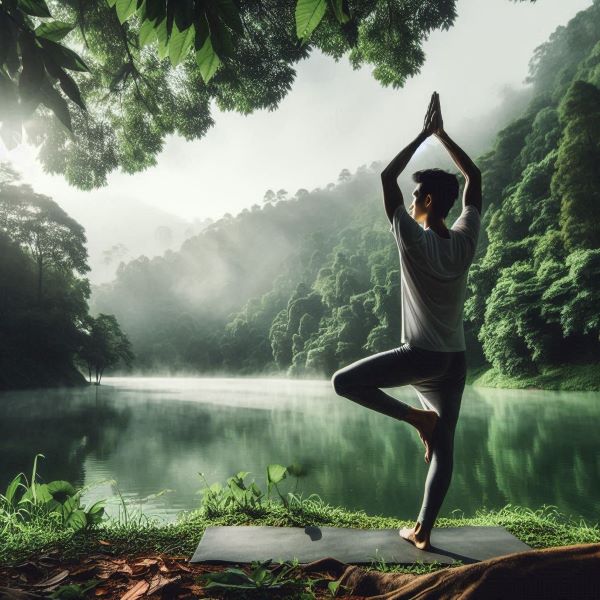Vrksasana, known in English as the Tree Pose, is a standing balancing posture that embodies the grace and stability of a tree. This asana promotes mental clarity and physical balance, making it an essential pose in various yoga practices. Vrksasana is ideal for improving concentration and grounding oneself.
History
The name Vrksasana is derived from the Sanskrit words “Vriksha” meaning “tree” and “Asana” meaning “pose.” This posture has been practiced for centuries, often symbolizing the yogic quest for balance and rootedness in life’s fluctuations. Historically, Vrksasana has been featured in ancient yogic texts and is a staple in both traditional and contemporary yoga routines.
How to Do Vrksasana
To perform Vrksasana correctly, follow these steps:
- Starting Position: Begin in Tadasana (Mountain Pose), standing tall with your feet together and arms at your sides.
- Shift Your Weight: Shift your weight onto your left foot, grounding it firmly into the mat.
- Position Your Right Foot: Bend your right knee and place the sole of your right foot on the inner left thigh. Avoid placing it directly on the knee joint. If this is challenging, you can place your foot on the inner left calf or ankle.
- Find Your Balance: Once balanced, bring your hands together in a prayer position (Anjali Mudra) at your heart center.
- Extend Your Arms: If you feel stable, you can extend your arms overhead, keeping them either parallel, with palms facing each other, or with hands clasped together.
- Hold the Pose: Maintain the pose for 20-30 seconds, focusing on a fixed point in front of you to help with balance. Breathe deeply and steadily.
- Release: To release, lower your arms and right foot back to Tadasana. Repeat the same steps on the other side.
Health Benefits
Regular practice of Vrksasana offers numerous health benefits, including:
- Improving Balance and Stability: Enhances overall balance and stability by strengthening the muscles in the legs and core.
- Increasing Focus and Concentration: Calms the mind and improves focus by requiring concentration to maintain balance.
- Strengthening the Legs: Tones and strengthens the thighs, calves, ankles, and feet.
- Stretching the Groin and Inner Thighs: Provides a gentle stretch to the groin and inner thigh areas.
- Promoting Postural Alignment: Encourages proper posture by aligning the spine and shoulders.
Who Should Do Vrksasana
Vrksasana is beneficial for most individuals, especially those who:
- Seek to improve their balance and coordination.
- Want to enhance their concentration and mental focus.
- Are looking to strengthen their legs and core muscles.
- Wish to practice a grounding and calming pose as part of their routine.
Also, read: Quickly Learn all about Purvottanasana – Upward Plank Pose
Who Should Not Do Vrksasana
Certain individuals should take precautions or avoid practicing Vrksasana:
- Those with severe balance issues or vertigo should practice with caution and possibly with support.
- Individuals with ankle or knee injuries should avoid putting pressure on these joints.
- People with high blood pressure should keep their arms at their sides or in a prayer position instead of raising them overhead.
- Pregnant women should practice under the guidance of a qualified instructor to ensure safety.
Precautions to Take
When practicing Vrksasana, keep these precautions in mind:
- Avoid placing your foot directly on the knee joint to prevent strain or injury.
- Use a wall or a chair for support if you find balancing challenging.
- Engage your core muscles to maintain stability and protect your lower back.
- Focus on a fixed point (drishti) in front of you to help with balance.
- If you experience any discomfort or pain, release the pose and rest.
References and Sources
By incorporating Vrksasana into your regular yoga practice, you can enjoy its numerous benefits while enhancing your balance, concentration, and overall well-being. Always practice mindfully and consult with a yoga instructor if you have any health concerns.





